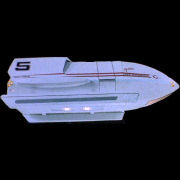Type-3 Personnel Shuttlecraft
- Type: Light short-range warp shuttle.
- Accommodation: Two flight crew, six passengers.
- Power Plant: One 50 cochrane warp engine, two 750 millicochrane impulse engines, four RCS thrusters.
- Dimensions: Length, 6.0 m; beam, 4.4 m; height 2.7 m.
- Mass: 3.38 metric tones.
- Performance: Sustained Warp 3.
- Armament: Two Type-IV phaser emitters.
The type 3 shuttlecraft was a short-range Starfleet auxiliary vehicle carried aboard Federation starships and space stations during the 24th century. The type 3 shuttlecraft was introduced sometime prior to 2364. They are part of the standard shuttlecraft loadout aboard Galaxy class, Intrepid-class , and Nebula-class starships. Space stations such as Relay Station 47 also support type 3 shuttlecraft
The Type 3 Personnel Shuttlecraft is currently in declining use throughout Starfleet. The Uprated version of this vessel is considered to be the ideal choice for short-range interplanetary travel, and its large size makes it suitable to transport personnel and cargo over these distances. A short-range transporter is installed onboard, allowing for easy beam out of cargo and crew to and from their destination. Atmospheric flight capabilities allow for this shuttle type to land on planetary surfaces. Ships of this type are currently in use aboard virtually every medium to large sized starship class, as well as aboard stations and Starbases.
The Type 3 is perhaps the most successful shuttle design to date, and its overall structure and components are the foundations upon which the latter and successful Type 6, spaceframe wasbased.
Major technological advancements in the 2370’s allowed for further upgrades to be made to the engine systems aboard shuttlecraft. These upgrades make this craft more capable of long-range spaceflight and, like its starship counterparts, no longer damages subspace.
